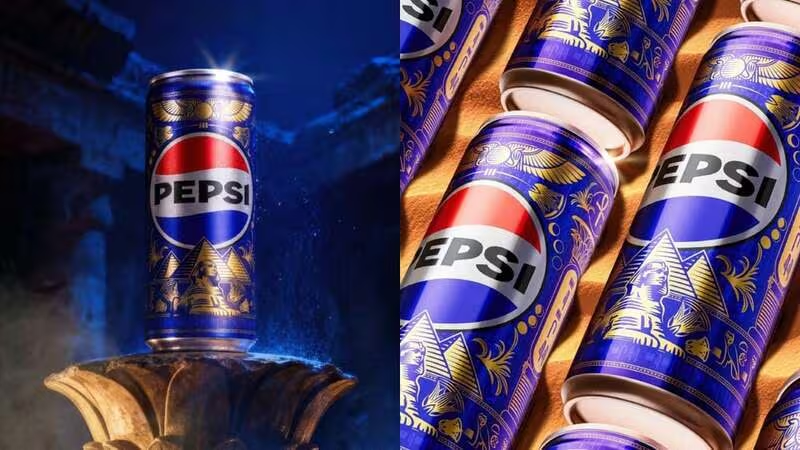
When Pepsi Egypt launched its latest limited-edition can, it wasn’t just about a refreshing drink—it was about celebrating centuries of artistic heritage. The striking design, inspired by the grandeur of ancient Egypt, turned a familiar soda can into a visual homage to pyramids, hieroglyphs, scarabs, and pharaonic icons. Let’s dive into what makes this release unique, why it matters for branding and culture, and how it reflects broader marketing trends.
Pepsi Egypt revealed the specially designed can as part of a campaign tied to Egyptian cultural heritage and major national milestones. According to Trend Hunter, the design “integrates pyramids, the Sphinx, scarabs, and hieroglyphic motifs within the brand’s classic blue and red palette.” TrendHunter.com+1
The brand stated that the limited edition was launched in connection with the inauguration of the Grand Egyptian Museum, giving it added cultural weight. LinkedIn
It’s more than just decorative: the packaging becomes a storytelling medium, blending ancient artistry with a modern consumer product.
By choosing a heritage-driven design, Pepsi Egypt shifts from being simply a global soda brand to a local cultural participant. The campaign gives the brand relevance beyond taste and refreshment—it ties it to national pride and visual culture.
Packaging is no longer just functional—it’s a canvas. When your soda can features hieroglyphs and pyramid motifs, it invites consumers to engage, share, even collect. In an era of social media, visual uniqueness adds shareability and buzz.
Incorporating Pharaonic artistry is a strategic move. It taps into Egypt’s global cultural cachet and allows the brand to align itself with the country’s historic legacy. This resonates not only locally but also for tourists and designconscious consumers worldwide.
Ancient motifs: The can incorporates hieroglyphic patterns, scarab shapes, and pyramid silhouettes—each element referencing Egyptian antiquity. TrendHunter.com+1
Modern brand identity: Despite the historical theme, the design remains recognisably Pepsi—with the signature red, white and blue employed alongside gold and beige tones that evoke antiquity. Ads of the World
Limited-edition status: By making it a collectable item, Pepsi Egypt adds exclusivity. Fans of design, heritage, and packaging may seek it out, boosting engagement.
Strategic timing: Launching it around cultural or museum events deepens relevance and media interest. For example, aligning with the Grand Egyptian Museum’s opening helps anchor the campaign in a real cultural moment. LinkedIn
Localization of global brands: Even big global brands benefit from local tailoring. By embedding Egyptian heritage, Pepsi Egypt shows how global and local identities can merge.
Packaging as storytelling: Rather than just displaying a logo and product info, the design tells a story. That story creates emotional connection and talkability.
Collectability and shareability: Limited editions create urgency and encourage consumers to share on social media—“look what I found” posts help extend the campaign organically.
Heritage meets modernity: Using ancient themes in modern products gives the brand depth and layers of meaning. It can elevate a commodity into something more cultural.
Know your cultural references: If you’re going to lean into heritage, make sure the reference is authentic and respectful.
Blend brand identity with theme: Don’t lose your core brand visuals while adopting new motifs. Pepsi kept its colours while layering Pharaonic art.
Create scarcity: Limited editions help drive attention and perceived value.
Use timing wisely: Align with a cultural event or national moment to maximise impact.
Make it shareable: Visual, photo-friendly designs spread more easily on Instagram, TikTok and other platforms.
Over-theme risk: If the heritage design overtakes the brand identity, it may confuse consumers. The balance between theme and brand must stay clear.
Short-lived buzz: Limited-edition campaigns often generate initial excitement—but sustaining relevance takes extra work.
Authenticity: If the cultural tie-in doesn’t feel genuine (or is seen as superficial), consumers may push back.
Accessibility: If the limited edition is too scarce or only available in niche outlets, many fans may feel excluded.
Pepsi Egypt’s limited-edition can celebrating Pharaonic artistry is a great case study in how packaging can transcend its function and become a cultural statement. It shows how a global brand can localise meaningfully, how heritage can be tapped for modern relevance, and how visual design can amplify storytelling.
For brands, marketers, or design enthusiasts, it’s a reminder: packaging is more than just a wrapper—it’s a space for narrative, pride, and connection.